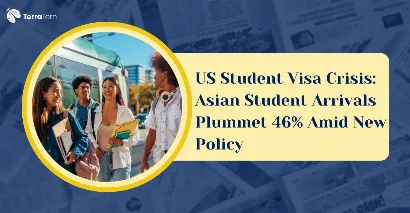Key Highlights
The crisis in international education is more significant than ever in the United States because student visa arrivals in the US fell to an alarming level in July 2025. New statistics also show that the total number of student visas into the country is down a disastrous 28 per cent, with the most substantial decline in those arriving from Asia, making up America's most significant international education market.
Record-Breaking Decline Hits Asian Markets
The newest data from the International Trade Administration paints a dismal picture of higher education in the US. In July of 2025, the arrival of the student visas from India, the largest source of international students, crashed by 46%. China, the second largest donor, saw a considerable decrease of 26 per cent over the same period.
This is the fourth month of the year-down decline, making 2025 an inflexion point in international education issues. The cumulative arrivals declined to below 79,000 students, the most significant monthly decrease this year.
Also Read: How Many Types of Visas are in the USA? New Full Expert Guide
Trump Administration Policies Create Perfect Storm
The sudden declining trend is the direct result of policy alterations made by the Trump administration in 2025. During prime student application time, the government declared that it would put student visa interviews on hold later in May.
When the vetting of social media accounts became a mandatory process of the State Department in the middle of June, the process became even more difficult for future students. In cooperation with increased screening procedures and appointment delays, these steps have led to uncertainty far beyond the standard security issue.
Yet why the worry is valid, said Zuzana Cepla Wootson, deputy director of federal policy at the Presidents' Alliance on Higher Education and Immigration. It is more of a larger trend in the present government. The travel ban, the expanded screening procedure, and backlogs in appointments leave the students of China and India, in particular, with uncertainty".
Financial Catastrophe Looms for Universities
In the case of universities in the US, this has thrown the institutions into a state of financial disaster to an extent that has never been witnessed before. It is estimated that the number of first-time international students will decline by nearly thirty per cent in this fall semester. Such a slip is potentially devastating, as it is estimated to cost the education field 2.6 billion dollars in tuition.
The Universities with big Asian student bodies are particularly badly hit. The University of Southern California is still struggling with a deficit of 200 million dollars, and may further lose tens of millions due to a continued decline and fall in enrollments. Arizona State University president Michael Crow characterised the visa backlog as more disruptive than the pandemic.
Historical Context Shows Unprecedented Scale
The already intense crisis becomes even more panicked when it is considered against the historical enrollment figures. The overall number of international students in the US reached a record 1.1 million in the 2023- 24 academic year. Foster students were mainly in India and China, accounting for nearly 332,000 and 277,000 students, respectively.
This background makes India's current 46% deflation an unimaginable turn. In the first half of 2025, 44 per cent of F-1 visa issuances were reduced to students coming to India compared to the same period in 2024. This fall is the same as that experienced in other prime destinations of the major English-speaking countries, showing a preference change by the Indian students globally.
Also Read: Cost of Transit Visa for USA: New Fees & Process Guide
Visa Processing Delays Create Cascading Effects
Policy shifts have had cumulative impacts up and down the education pipeline to the international education channel. The visa interview respite occurred at a time of year when students usually make their final arrangements to attend the fall semester. Such timing is not good news to August entries, which are noted to be the highest in entrant number.
The present students already in the US can also be impacted. This summer, many international students opted out of a trip home because they felt they were under increased scrutiny when returning. This is indicative of the fact that the policy changes have an impact not only on new admissions but also on the retention of students who are already enrolled.
Regional Impact Varies Across Asia
Although the sharpest falls were registered in India and China, the effects on Asian markets differ. The First half of 2025 data indicate that some Asian countries added to the US student numbers. There was an increase in visa issuances in Bangladesh, Pakistan, and Vietnam, which suggests that students in emerging markets are replacing some of the lost markets of traditional countries.
Nonetheless, these gains outweigh huge losses in India and China, which historically contribute more than 42% of new international students in the US. Diversification of source countries is positive for long-term stability, yet it cannot immediately substitute the number of students and the economic contribution of Indian and Chinese students.
Universities Adapt Strategies Amid Crisis
The crisis is causing a fast change in universities' recruitment and retention practices. Attracting potential students, many institutions are paying attention to career readiness programs, peer and alumni relationship programs, and international partnerships.
The focus on Optional Practical Training (OPT) opportunities has been growing. In 2024-2025, a record 271,916 international students will be enrolled in OPT programs, an increase of 12 per cent over the prior year. The trend indicates that universities understand that career outcomes are one of the main determinants of international student choices.
Long-term Implications for US Higher Education
The prevailing decline poses the risks of structural reorganisations in US higher education. International students, particularly students of Asian origin, have long played a significant role in STEM programmes and research activities. Their non-presence can weaken America competitively in terms of science and technological education.
The economic situation in most universities relies considerably on international students' tuition rates, which are usually higher than those of home students. A persistent downturn may mean institutions will be forced to increase domestic tuition, cut programs, or otherwise take cost-cutting measures that may ultimately drive down the quality of provision.
Also Read: Top Software Engineer Jobs in USA: New Pay, Scope & More
Global Competition Intensifies
Competitor destinations have been busy wooing pushed-out students as the US struggles with issues in visa processing. Canada, Australia, the United Kingdom, and other countries have opened their visa channels and increased measures to work after college degrees.
Canada has especially received benefits from the US policy uncertainty, and demand for Indian students in the country also declined drastically in 2024. The fall of Indian student demand in Australia by almost 20 per cent when comparing 2022-23 to 2023-24 indicates that these expectations could also be extended to the global pattern rather than the US-specific policy.
Conclusion
The decline in US student visa arrivals constitutes a potent turning point in American higher education. July 2025, when the total number of arrivals fell by 28 per cent and India effectively collapsed by 46 per cent, constitutes a recent, unprecedented crisis. The decision by the Trump administration to bend the policy in passing visas has created an impending perfect storm that is likely to permanently change the face of education in the US, with the universities facing unparalleled financial losses and the overall global leadership in education in question.
With competitor nations cashing in on this policy-induced outflow, the big question now is whether any remedial response can be taken now that will have the swiftness to change the direction that the US takes before the detrimental damage erodes all the work through international education and economic gain, which has in the past made the US the global number-one study destination. Contact TerraTern for more information!








